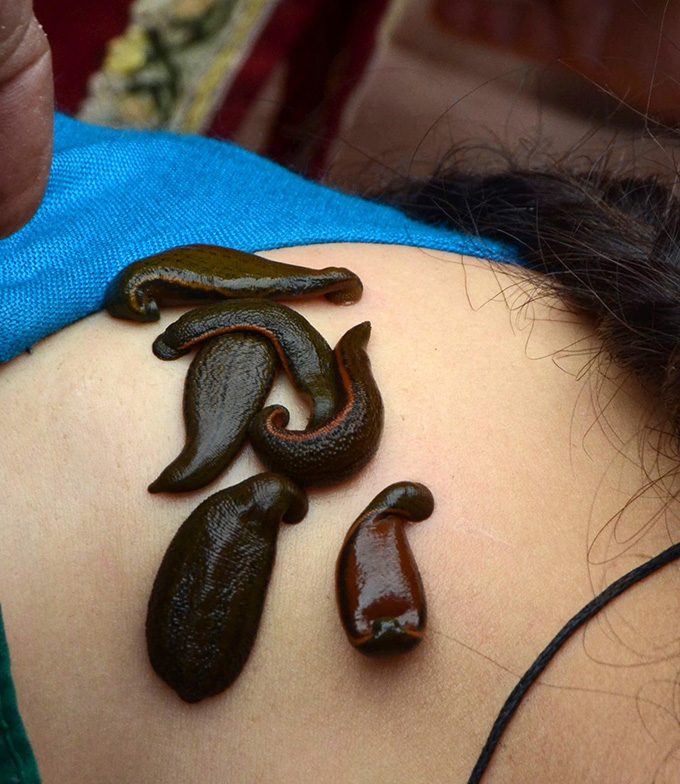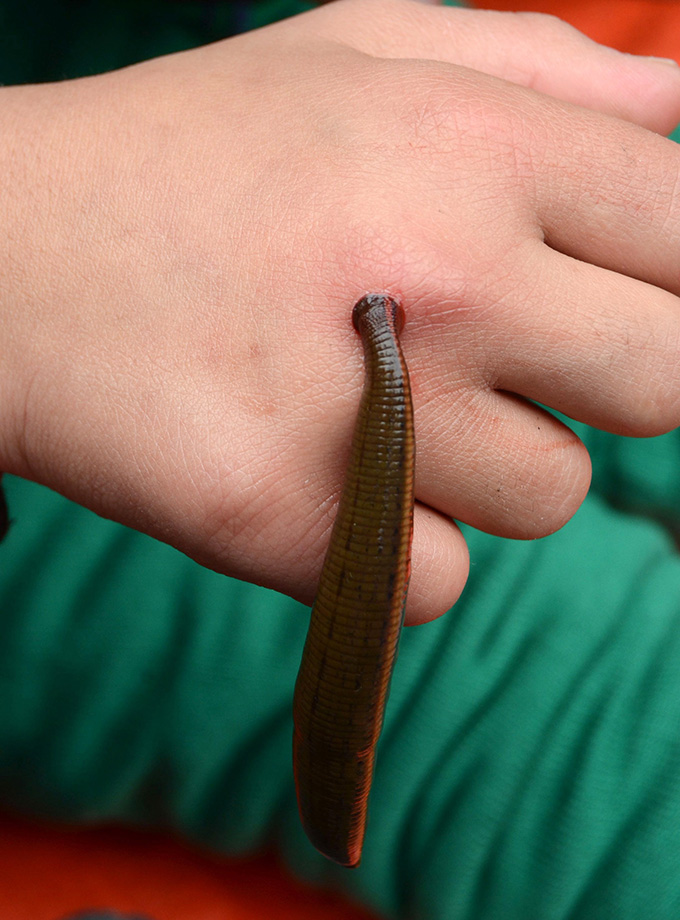by Umair Shafiq Khanday
Chemicals derived from leech saliva have been made into pharmaceutical drugs that are used in the treatment of hypertension, varicose veins, haemorrhoids, and arthritis. Clinical trials suggest by trusted sources that leech therapy is an appropriate treatment for the common joint disease osteoarthritis. The anti-inflammatory and aesthetic properties in the leech’s saliva reduce pain and tenderness at the site of the affected joint.

Leech is a kind of bloodthirsty hermaphrodite. The genus Hirudo is known as medicinal leeches.
The behaviour of blood-sucking by an external parasite like leeches can have different consequences because of piercing the surface of the hosts’ body. The leech bite causes direct connections between its body and the host’s body.
Nawroz is celebrated on March 21, and this is marked as the beginning of the Persian calendar. Besides planting trees, Kashmiris celebrate it as the mark of the new agricultural season with seeds being sown and farms made ready. But this is not only the reason for celebration. Kashmiri people wait for this day to undergo leech therapy.
Leech therapy is an old practice and it dates back to 200 BC.
The practitioners believed that leech therapy cures many diseases like skin diseases, arthritis, chronic headaches, and sinusitis. This therapy is used because of the severe cold in Kashmir, which leads to scars and other chronic diseases. There are many beliefs associated with this tradition. Leech therapy cleans the impure blood. It helps in lowering uric acid in the body.
In Kashmir, there are six hospitals that are using this technique to treat patients suffering from chronic diseases.
Leech therapy is not only popular in Jammu and Kashmir but is in vogue in many countries. Ancient Arabs, Egyptians and Greeks have also used this therapy to treat diseases. Many people are now considering leech therapy as a better option for treatment rather than pharmaceuticals treatment. These secretions are also known as anticoagulants. This keeps blood flowing to wounds to help them heal. Currently, leech therapy is seeing a revival due to its simple and inexpensive means of preventing complications.
How does leech therapy work?
Medicinal leeches have three jaws with tiny rows of teeth. They pierce a person’s skin with their teeth and insert anticoagulants through their saliva. The leeches are then allowed to extract blood, for 20 to 45 minutes at a time, from the person undergoing treatment. This equates to a relatively small amount of blood, up to 15 millilitres per leech. Medicinal leeches most often come from Hungary or Sweden.
There are several situations in which leech therapy may be used. People who may benefit include those who risk limb amputation due to the side effects of diabetes, those who have been diagnosed with heart disease, and those who are undergoing cosmetic surgery in which they risk the loss of some of their soft tissue. The therapy has also been recommended to treat blood clots and varicose veins.
 Diseases which leech therapy can treat include skin diseases (eczema, seborrhoea), eye diseases (inflammatory diseases of the eyelids, cornea, sclera, conjunctivitis) ENT diseases (acute neuritis of the auditory nerve, ear noises chronic neuritis, acute rhinitis, acute sinusitis; forunkulez outer ear, acute laryngotracheitis, acute outer (middle) otitis media, chronic adhesive); respiratory diseases (influenza, acute respiratory infection, herpetic lesions of the nose, lips, and others.); and diseases of the gastrointestinal tract (gastritis, stomach ulcers, colitis, varicose veins, post-surgical thrombosis, thrombophlebitis, endarteritis, haemorrhoids).
Diseases which leech therapy can treat include skin diseases (eczema, seborrhoea), eye diseases (inflammatory diseases of the eyelids, cornea, sclera, conjunctivitis) ENT diseases (acute neuritis of the auditory nerve, ear noises chronic neuritis, acute rhinitis, acute sinusitis; forunkulez outer ear, acute laryngotracheitis, acute outer (middle) otitis media, chronic adhesive); respiratory diseases (influenza, acute respiratory infection, herpetic lesions of the nose, lips, and others.); and diseases of the gastrointestinal tract (gastritis, stomach ulcers, colitis, varicose veins, post-surgical thrombosis, thrombophlebitis, endarteritis, haemorrhoids).
People with anaemia, blood clotting conditions, or compromised arteries are not candidates for leech therapy. Children under the age of 18 years old and women who are pregnant are also usually advised to avoid it.
Medical Applications

During a session, live leeches attach themselves to the target area and draw blood. They release the proteins and peptides that thin blood and prevent clotting. This improves circulation and prevents tissue death. The leeches leave behind small, Y-shaped wounds that usually heal without leaving a scar. Leeches are effective at increasing blood circulation and breaking up blood clots. It should be no surprise that they can be used to treat circulatory disorders and cardiovascular disease.
Chemicals derived from leech saliva have been made into pharmaceutical drugs that are used in the treatment of hypertension, varicose veins, haemorrhoids, and arthritis. Clinical trials suggest by trusted sources that leech therapy is an appropriate treatment for the common joint disease osteoarthritis. The anti-inflammatory and aesthetic properties in the leech’s saliva reduce pain and tenderness at the site of the affected joint.
(The author is a student of BSc Nursing at Pacific Institute of Medical Sciences, Udaipur. The opinions expressed in this article are those of the author’s and do not purport to reflect the opinions or views of Kashmir Life.)















